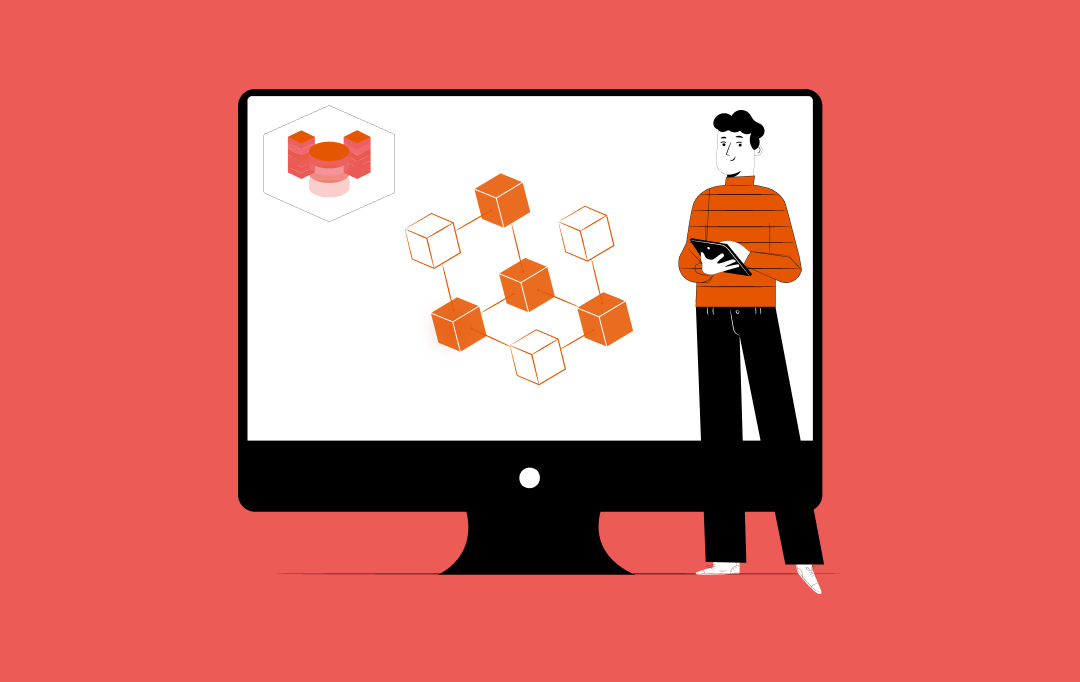- The Origin of Blockchain Interoperability Solutions
- Business Benefits of Blockchain Interoperability
- The Common Blockchain Interoperability Solutions
- Web2 Validation
- External Validation
- Local Validation
- Native Validation
- Blockchain Interoperability in Business Best Practices
- The Future of Blockchain Interoperability in Business
- FAQs
Blockchain has been a revolutionary response for industries facing the growing pressure of centralized operations’ limitations. By building an ecosystem which runs on zero trust, the technology introduced the world with processes that were incredibly neutral, change-proof, and 100% transparent when compared to their predecessors – traditional computing environment.
Having reached a stage where blockchain has established its credibility across industries, the technology now faces an oracle problem – reliance on an Internet connection. Since blockchains don’t have built-in communication capabilities with external APIs or other blockchains, it not only prohibits them from interacting with the traditional systems but also hinders interoperability with other blockchains.
With the growing traction of a multi-blockchain world, interoperability protocols are fast becoming a critical infrastructure for exchanging tokens and data between blockchains.
Through this article, we will deep dive into the concept and necessity of blockchain interoperability for businesses, giving you an understanding of how the process works and the changes to expect from its implementation.
The Origin of Blockchain Interoperability Solutions
The importance of blockchain interoperability can be understood best by keeping it on the same spectrum as globalization. The technique gives blockchain systems the ability to open up asset flow which is locked in individual chains.
Like nations, blockchains can also specialize and function better than others in specific areas. While some blockchains could be ideal for minting new NFT, others might offer extremely low transaction charges. Moreover, for some dApps, the place where the chain sits would be a deciding factor for providing scalability and security in a decentralized environment.
Opening the connection between these specialized blockchains does a lot more than simply creating opportunities for existing applications to scale. It builds opportunities for new apps and use cases to emerge – examples of which exist across the economic history, from the new domains of businesses due to globalization, to the rise of new e-businesses, which increased interoperability on the web.
While this is happening on a macro level, on the ground level, the lack of interoperability was causing a number of persistent issues leading to companies asking for solutions focused on blockchain interoperability for businesses.
- Absence of a direct interoperability between Ethereum and Bitcoin limits bitcoin users from using their crypto funds within Ethereum.
- Users cannot directly transact BTC for ETH without the presence of a centralized cryptocurrency exchange.
- Although Ethereum and Binance Smart Chain both support USDT, one cannot send USDT from Ethereum to Binance Smart Chain or any other blockchain.
- Blockchain evangelists want to implement Blockchain in the traditional financial system. But if two banks use different blockchains, conducting transactions between them will be complex, leading to blockchain creating a segregated system rather than a unified one.
Also Read: How Much Does it Cost to Develop a Cryptocurrency Exchange App like Coinbase?
The more we dive into blockchain interoperability, the more one thing becomes clear – the situation is of critical importance for decentralized platform owners who are looking for better scalability and the perks that come with it. Let us look into some of the obvious benefits of achieving blockchain interoperability.
Business Benefits of Blockchain Interoperability
As the blockchain space expands, interoperability is becoming increasingly critical for determining a project’s success. While blockchain interoperability’s global valuation is poised to reach $3 billion by 2034, in 2025 itself, we’ll see more interchain collaborations and developments happening as companies continue to push for greater blockchain efficiency, scalability, and privacy.

Emergence of Reliable Platforms: One of the significant benefits of blockchain interoperability for businesses is that it enables different blockchains to connect, allowing users to easily transact across multiple platforms. Through this, companies would be able to build more secure and reliable platforms, which would depend on multiple blockchain networks that are known for completing transactions safely and effectively.
Scalability: One of the most evident challenges blockchain struggles with is scalability. Companies will be able to overcome this hindrance by using various interoperable blockchain solutions. As a result, developers would also be able to create more sophisticated applications and services without any obvious or unforeseen performance issues or paying significant transaction charges.
Improved Ecosystems: The role of blockchain interoperability in businesses enables improved communication between blockchains, building a better ecosystem for both businesses and users. We can expect to see increased interchain collaboration as brands work towards providing their customers with innovative services and products.
Increased Efficiency: Cross-chain communication can create a space for introducing greater efficiency in the blockchain space. By using data from different blockchains, companies can lower the cost and time associated with multi-platform transactions, allowing faster transaction settlement and better experiences.
Enhanced Security: Interoperability can create a system for enhanced safety on the blockchain by creating robust consensus mechanisms, which ultimately make it difficult for malicious actors to take network control. In the future, we are likely to see projects taking advantage of this to build more secure systems for the users.
Lower Costs: Another evident importance of blockchain interoperability can be seen in reduced business costs. Companies can use data from multiple blockchain networks to create efficient processes, which helps lower operational costs and build upon overall profitability.
Open Source Projects: Blockchain interoperability can power the creation of open-source projects, which range across multiple blockchains. These projects, in turn, will allow developers to create innovative apps and services without thinking of compliance or compatibility issues.
Increased Transparency: Another one of the critical business benefits of blockchain interoperability lies in companies being able to provide greater visibility into their operations through multiple blockchain connectivities. This increased transparency guarantees customers direct access to up-to-date information on transactions on the network, which ultimately helps build trust between the company and them.
Real-time Data Exchange: Blockchain interoperability allows a real-time data exchange among multiple networks. It can help companies scale faster as they are able to quickly identify new growth opportunities and respond to customer requests more efficiently.
Enabling an Era of Innovation: Interoperability could also enable a new generation of innovation. By creating an open, interconnected ecosystem, developers can create powerful applications and services that leverage the best features from multiple blockchains. As a result, they could lead to new categories of products and services that benefit businesses and consumers alike.
Unlocking Use Cases: Importance of blockchain interoperability can also be seen in the technology unlocking new business use cases. By obtaining data from different blockchains, businesses can create more personalized solutions that are better suited to their customers’ requirements – along the way, they can tap into applications that are yet to come on the surface.
Lowering Single Points of Failure: Interoperability lowers dependance on a single blockchain network, eliminating the probability of disruptions while guaranteeing operations’ continuity. In the event of network failure, transactions can get routed through alternative pathways, augmenting reliability and resilience. This distributed architecture directly lowers the chance of systemic failures and improves the blockchain ecosystem’s robustness.

This list of benefits highlighting the importance of blockchain interoperability for businesses, while expansive, is still only scratching the surface. The true potential will emerge only after businesses have incorporated interoperability in their decentralized offerings.
Let us look at the ‘how’ in the next section.
The Common Blockchain Interoperability Solutions
The best starting point when talking about blockchain interoperability solutions would be to look into the most popular cross-chain interactions.
- Token swaps – Involve trading a token on source chain and then receiving a separate token on the destination chain. These cross-chain token swaps are usually done through atomic swap protocols and/or cross-chain automated market makers (AMMs), which place different liquidity pools on every blockchain to power the swap.
- Token bridges – Comprise locking or burning the tokens through a smart contract on a source chain and then minting or unlocking tokens through a separate smart contract active on the destination chain. Token bridges enable assets to move across blockchain networks, increasing the token utility as a result.
- Native payments – Involve an app present on the source chain triggering the payment on the destination chain in the native asset. The cross-chain payments can also be done on the source chain in its native asset on the basis of the data from a separate blockchain network.
- Contract calls – Here a smart contract present on a source chain calls upon a smart contract function deployed on the destination chain, potentially on the basis of data that originates on the source chain. Several contract calls can be merged to shape a complex cross-chain app, which might involve token bridging and swaps.
To power these cross-chain interactions, four interoperability solutions are used. These solutions validate the state of a source blockchain and relays the ensuing transactions to the destination blockchain. Both these functions – state verification and relay – play a key role in completing cross-chain interactions.
Web2 Validation
Web2 validation happens when someone uses a Web2 service for executing a cross-chain transaction. A common example of this can be seen in users leveraging centralized exchanges for swapping or bridging their tokens. The user simply has to deposit their assets in a source chain address that’s under the exchange’s control and then withdraw the same or different tokens (via a swap) to a destination chain address controlled by them.
External Validation
External validation is when the validator nodes set from all the blockchain of the cross-chain interaction are used for validating the state of the source blockchain and triggering the subsequent transaction on the destination chain after a specific criteria is met. While there are a number of approaches to address committee-based consensus – decentralized oracle networks, multi-party computation, threshold multi-signature contracts – all of them involve validator nodes for trust-minimized off-chain computation which gets authenticated on-chain.
Local Validation
Local validation is when the cross-chain interaction counterparties verifies the state of each other. If both consider the other valid, a cross-chain transaction gets executed, resulting in successful peer-to-peer cross-chain transactions. These cross-chain swaps which are based on local validation are often called atomic swaps. These atomic swaps come with a high level of trust-minimization with reasonable blockchain assumptions, as swap either happens successfully or both the transactions fail.
Native Validation
Native validation happens when a destination blockchain active on a cross-chain interaction verifies the source blockchain state to confirm transactions and then executes a subsequent transaction on their own chain. This is typically performed by running a light client of the source chain in the destination chain virtual machine or by running both side-by-side.
While these solutions are being incorporated by leading blockchain firms like Chainlink, Cosmos, and Polkadot, etc. to create better connectivity between the networks, the success is highly dependent on how well/strategic the interoperable systems are.
At Appinventiv, when we work on blockchain software development, we believe that the project to be truly scalable, future-oriented, and effective, its interoperability mechanism should be strategically built. On that note, here are the requirements that we share with our clients to make their blockchain interoperability ready.
Blockchain Interoperability in Business Best Practices
The impact of the role of blockchain interoperability in businesses is highly dependent on how well it is implemented in the solution. The interoperability model usually works around three layers that address all the cross-chain challenges.

Business Model Layer
When two blockchain ecosystems transmit data, the governance models that are working behind these ecosystems must be easily comparable with each other, alongwith a well-defined legal framework and commercial arrangements. Believing that technical feasibility can enable interoperability is very short-sighted and thus be avoided.
Here are the questions that businesses should answer in this layer –
- To which industries and data standards do these participants adhere?
- Are any of these participants currently part of an existing blockchain ecosystem? If so, what data standards are utilized?
- What methods should participants use to discover, exchange, and apply relevant distributed data across different ecosystems?
- Does the intended use case require features provided by related ecosystems, such as payments or trade finance in supply chain scenarios?
- How can we prevent or mitigate interoperability risks like exposing information to untrusted third parties and losing access to information on secondary chains?
Platform Layer
When two ecosystems exchange data points, blockchain interoperability calls for a careful consideration into assuring that the platform layers are technically compatible with the consensus mechanism, authentication, and smart contract.
Here are the questions that businesses should answer in this layer –
- Are any participants already engaged in an existing blockchain ecosystem? If so, what blockchain platform do they use, and which consensus mechanism is it based on?
- Do the blockchain platforms support similar multi-signature transactions for authentication and authorization? For instance, does one platform authenticate at the user level while another does so at the node level?
- Can we develop a cross-authentication mechanism?
- Considering a notary scheme-based interoperability solution, is it practical to trust a third party to operate a notary scheme for cross-chain interoperability, or does it conflict with the decentralization goal?
- If using a relay-based interoperability solution, why were the two ecosystems initially built on different blockchain technologies? How can participants in the application layers of two distinct blockchains establish trust, given their differing consensus mechanisms and governance models?
- Can an API gateway be established?
Infrastructure Layer
The infrastructure layer works with a set of components that enables blockchain platform’s services. These usually include, but are not restricted to, computation, storage, networking, and virtualization.
Here are the questions that businesses should answer in this layer –
- Will the use case subject the solution owner to regional legal constraints regarding data storage locations or something else?
- Does the use case enable the solution owner to deploy it on a virtual private cloud?
- Can the use case utilize Blockchain-as-a-Service (BaaS) offerings?
- Is the IT organization sufficiently mature to manage hosting nodes, wallets, secure keys, or tokens?
Here were the blockchain interoperability in business best practices that we typically suggest our clients to follow when they are on the journey to scale up, irrespective of the use cases they are exploring.
As we conclude the article, let us look into what the future holds for blockchain interoperability for businesses.
The Future of Blockchain Interoperability in Business
There is a pivotal need for siloed blockchain networks to communicate with each other effortlessly. In the absence of a blockchain abstraction layer, dApps depend on separate, in-house integrations for every cross-chain interaction they want to use – a process known for being incredibly resource-intensive, time-consuming, and complex.
With the industry-wide focus shifting on finding and expanding the scope of blockchain interoperability for businesses, we will see a number of interoperability platforms coming into existence. Along with this, new partnerships will form in the tech space as businesses explore new use cases.
While this is on the business end, customers or the end users are definitely in for a treat with them becoming more confident in using blockchain applications and being on a center stage as interoperability opens innumerable use cases.
FAQs
Q. What is blockchain interoperability?
A. It refers to the ability of different blockchain networks to communicate and interact with one another seamlessly. This functionality enables the transfer and exchange of data, assets, and information across various blockchain platforms without requiring intermediaries. It aims to create a more connected and efficient blockchain ecosystem, enhancing the overall utility and versatility of blockchain technology.
Q. How does blockchain interoperability work?
A. Blockchain interoperability for businesses works by using standardized protocols, bridges, and cross-chain communication mechanisms that allow different blockchains to exchange information and assets. These technologies enable blockchains to understand and validate data from other networks, facilitating seamless interaction.
Smart contracts, atomic swaps, and interoperability platforms like Polkadot and Cosmos are some of the tools that help achieve this connectivity, ensuring that transactions and data transfers are secure and efficient across multiple blockchain networks.
Q. How can blockchain interoperability improve business efficiency?
A. The approach can significantly enhance business efficiency by enabling seamless data sharing and transactions across different blockchain platforms. This eliminates the need for intermediaries, reduces operational costs, and speeds up processes. Businesses can leverage interoperable blockchains to streamline supply chains, enhance transparency, and improve collaboration with partners using different blockchain technologies. This interconnected approach allows for more efficient and secure business operations, fostering innovation and scalability in various industries.


Excellence Together

The Rise of Blockchain in Digital Marketing - Benefits, Use Cases and Challenges
Blockchain technology is revolutionizing digital marketing by transforming strategies through its decentralized and secure framework. It provides marketers with unparalleled transparency in campaign tracking and data management, guaranteeing increased security and privacy for users. As the digital landscape is advancing at a fast pace, blockchain in marketing offers the digital marketers with the means to…

How to Build a DeFi App? Costs, Features, Process, Types
The current financial system, with its inefficiencies, high fees, limited accessibility, and lack of transparency, often leaves significant portions of the global population, especially in underbanked areas, at a disadvantage. Decentralized finance (DeFi) emerges as a solution to these issues, utilizing blockchain technology to remove intermediaries, thereby reducing costs and enhancing security. This shift towards…











